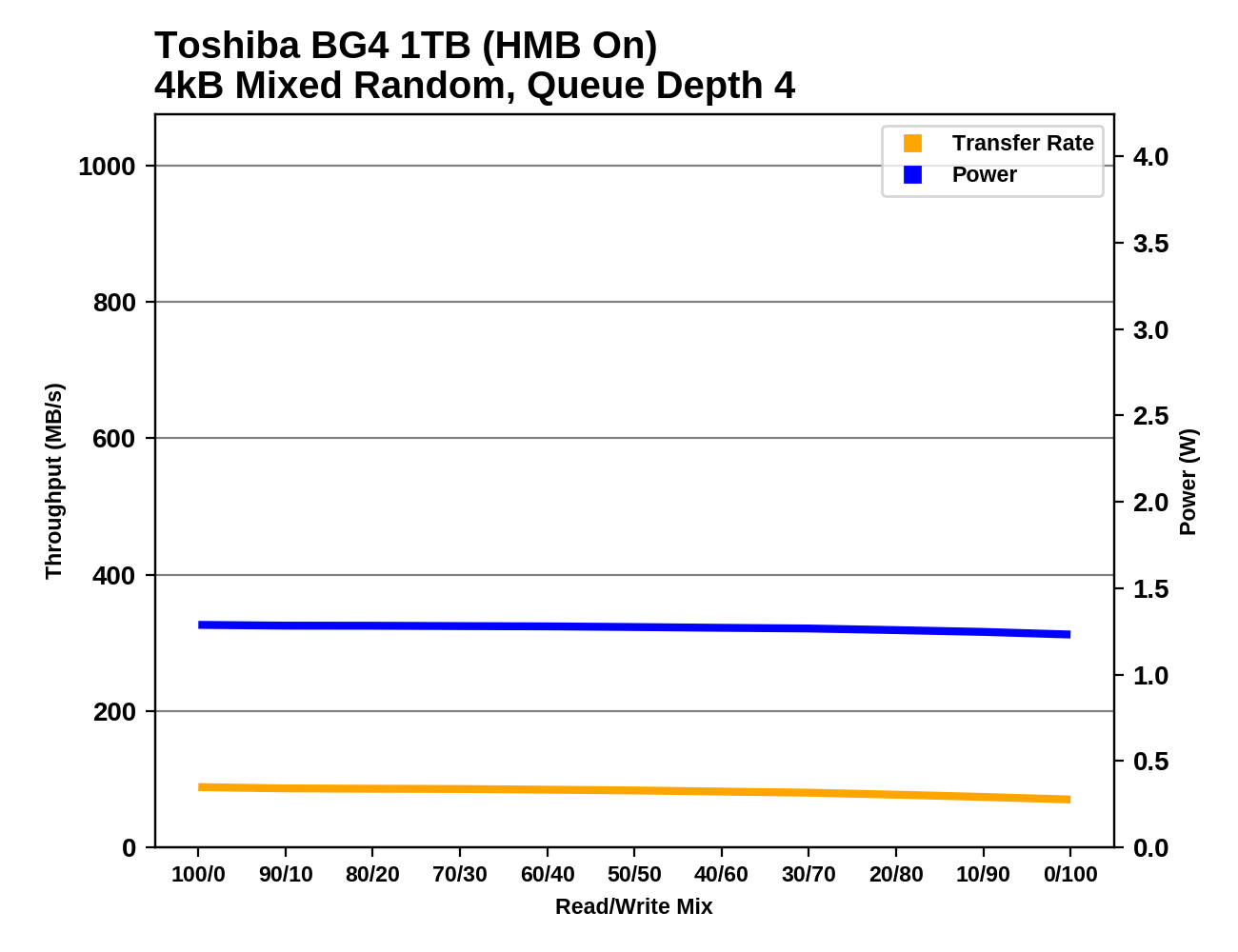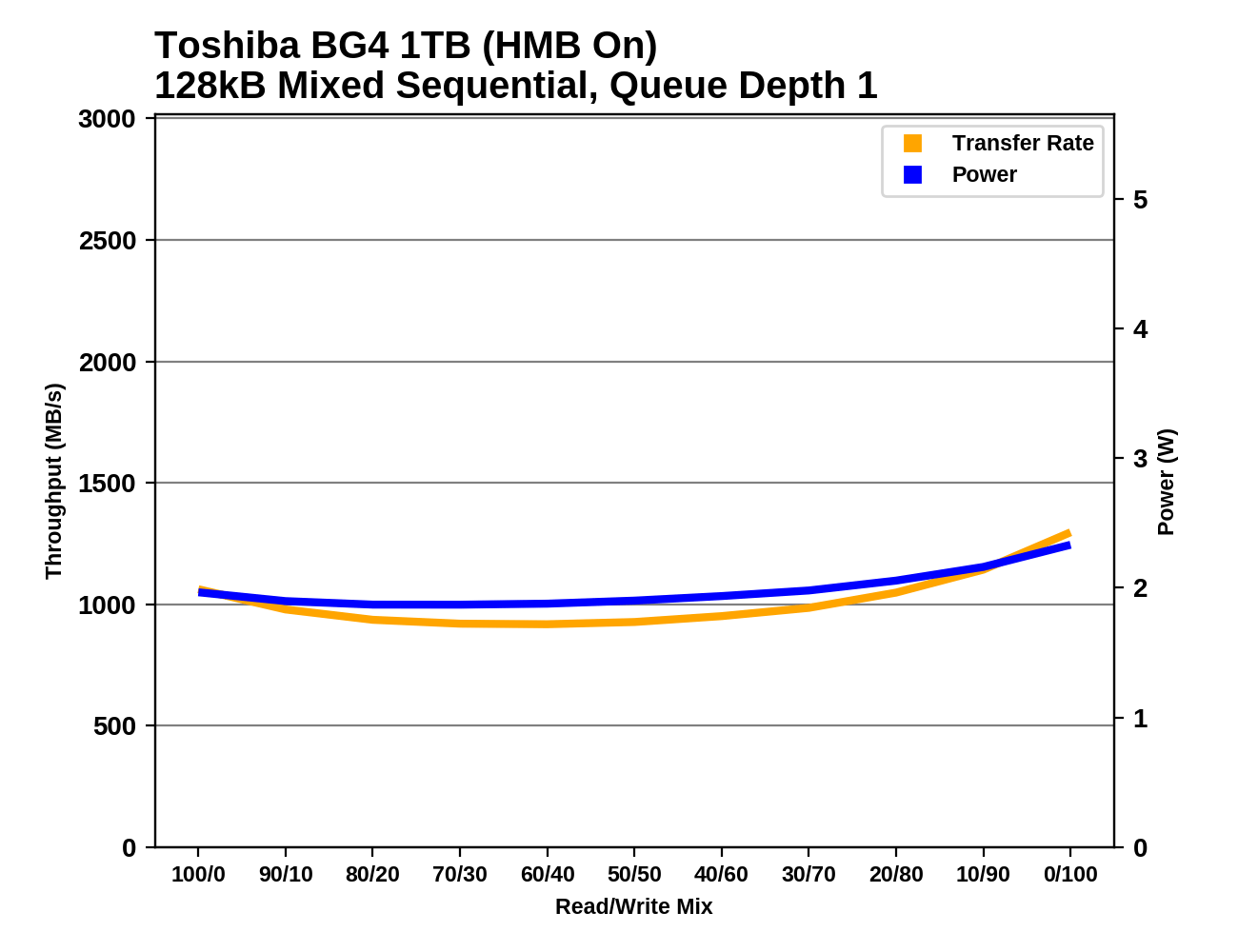The Toshiba/Kioxia BG4 1TB SSD Review: A Look At Your Next Laptop's SSD
by Billy Tallis on October 18, 2019 11:30 AM ESTMixed Random Performance
Our test of mixed random reads and writes covers mixes varying from pure reads to pure writes at 10% increments. Each mix is tested for up to 1 minute or 32GB of data transferred. The test is conducted with a queue depth of 4, and is limited to a 64GB span of the drive. In between each mix, the drive is given idle time of up to one minute so that the overall duty cycle is 50%.

This mixed random IO test covers a fairly wide span of the drive, so it's not a surprise to see that the Toshiba/Kioxia BG4 and other DRAMless SSDs end up being among the slowest drives overall, with HMB providing little or no help.
 |
|||||||||
| Power Efficiency in MB/s/W | Average Power in W | ||||||||
The power consumption of the BG4 during this test is as low as any other drive, but the limited performance means its efficiency score is still clearly worse than most of the drives that have their own DRAM.
 |
|||||||||
The performance of the BG4 is low and relatively flat across this test, declining slightly as the workload gets more write-heavy when most drives gain performance. With a working set small enough for the BG4's HMB configuration to be useful, we would likely see a very different performance profile.
Mixed Sequential Performance
Our test of mixed sequential reads and writes differs from the mixed random I/O test by performing 128kB sequential accesses rather than 4kB accesses at random locations, and the sequential test is conducted at queue depth 1. The range of mixes tested is the same, and the timing and limits on data transfers are also the same as above.

The BG4 is a bit more competitive on the mixed sequential IO test, almost matching the XG6's overall performance and more or less tied for fastest among the entry-level NVMe drives.
 |
|||||||||
| Power Efficiency in MB/s/W | Average Power in W | ||||||||
The BG4 comes out on top of the power efficiency rankings, with the WD Black SN750 a close second. Even with the lower performance of running without HMB, the BG4 stays near the top of the efficiency chart.
 |
|||||||||
Without HMB, the BG4's performance across the mixed sequential IO test is mostly flat, with a bit of an overall decline as the workload becomes more write-heavy. Enabling HMB allows the BG4 to pick up some speed during the last third of the test, but it doesn't have a huge impact.










31 Comments
View All Comments
eek2121 - Sunday, October 20, 2019 - link
There are a few 4 TB m.2 SSDs out there, they just sell out FAST so you typically won't even find them listed. You can still find plenty of 2 TB m.2 SSDs.mxnerd - Saturday, October 19, 2019 - link
Kioxia? Great product but what a bad brand name.s.yu - Sunday, October 20, 2019 - link
No surprise coming from Japanese manufacturers recently........s.yu - Sunday, October 20, 2019 - link
Looks like the takeaway from this is although Toshiba SSDs consistently fall behind Samsungs (the main reason they're regarded as the short straw in flash lottery), they may be more efficient, but hardly anybody tests for that.discostrings - Sunday, October 20, 2019 - link
The Toshiba BG4 is actually already available in the M.2 2242 format in retail channels as the Sabrent SB-1342-2TB, SB-1342-1TB, and SB-1342-512:https://www.sabrent.com/product/SB-1342-2TB
Yes, that's right: there's a 2TB 2242 variant! I was hesitant to believe it was actually available in that capacity, as I didn't see any sort of announcement, but I received one on Thursday and I can confirm it's quite real.
Unfortunately, these aren't useful for most current laptops with 2242 slots (that are primarily included for WWAN but which can also use NVMe drives like the RC100). As these SSDs use four PCIe lanes, they require the M key, while all laptops that I know of direct two (or less) PCIe lanes to the 2242 slot, and thus have a B key that prevents use of these drives.
So there probably won't be much of a market for these until there are laptops out with M-keyed M.2 2242 slots. It would be great to see a 2-lane variant with a B key in the short term for use in current laptops.
discostrings - Sunday, October 20, 2019 - link
I mixed terminology up a little bit in my prior post. The Sabrent drives use Toshiba BiCS4 NAND (which is also used by in the Toshiba BG4), but these are not rebranded variants of the same drive. Apologies for any confusion.peevee - Monday, October 21, 2019 - link
So they already have brands Toshiba, Lite-On and Plextor, all pretty valuable and respectable (esp Plextor I think), why do they feel like they need another one?Billy Tallis - Monday, October 21, 2019 - link
The decision to rebrand from Toshiba to Kioxia was made before the decision to buy Lite-On's SSD business. Continuing to use the Toshiba brand name long-term isn't an option since they aren't part of the Toshiba conglomerate anymore and need to IPO under a name they own. They don't get to use the Lite-On name either because they didn't buy the whole company, just the SSD portion. They might now own the Plextor brand.Targon - Monday, October 21, 2019 - link
If the laptop maker has a decent design, then it would make more sense to go with a small capacity SSD to keep the laptop price down and then put a better SSD in yourself. Get something with a normal 1TB hard drive but has the support for NVMe, and you then throw in a 1TB drive yourself. No need to feed the stupidity of people wanting a tiny machine that has a slow processor just to keep power demands low. Going with even a 35 or 45 watt CPU with a 15 inch display will give you a much more powerful laptop than these 15W CPU machines with a 11 inch screen designed for people who sit in meetings all day but have much lower performance.At least we are beyond the days of Intel Atom crap machines in that space.
MykeM - Thursday, October 31, 2019 - link
You can actually get a external USB-C SSD that uses this particular Toshiba BG4 SSD. It’s made by CalDigit know for its excellent Thunderbolt 3 docks. It’s called Tuff Nano and at the moment only comes in the ½ terabyte capacity. The read speed is just over 1GB/s (if the device USB-C supports USB3.x Gen2). And it’s tiny:l:https://www.caldigit.com/tuff-nano